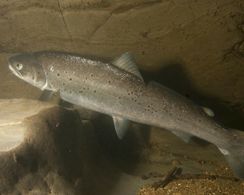

01 Dec, 2014 | by Labroots
Making Rare Disease Drug Research Pay OffWith drug companies investing huge amounts of time and money to produce viable products, it is not surprising that they look for drug candidates that will provide a return on the investment. Whereas rare diseases may not have been the way to go before, there are indications that the trend may be changing in some sectors. A case for developing drugs for rare, orphan diseases can be found in the most...... Read More

28 Nov, 2014 | by Labroots
Hopping And Hoping...After multiple months of waiting for final permits, the Oakland Zoo has acquired the necessary state and federal permits to help save the Mountain Yellow-Legged frog, a highly endangered amphibian. This frog species, which once hopped throughout California’s upper elevations, has dropped significantly in numbers, more than ninety percent in the past decade, due in part to chytrid, a skin fungus that...... Read More

27 Nov, 2014 | by Labroots
The Secret Life of the Sea TroutWhile not normally thought of as a dodgy character, the sea trout, a distant cousin of the Norwegian Salmon has a lot of secrets. Researcher Jan G. Davidson and his graduate students are on the case and trying to decipher the development and habits of the sea trout and in the process hopefully discover why there has been a 60% reduction in the numbers of sea trout in Norway. Similar to their salmon...... Read More

26 Nov, 2014 | by Labroots
How Can You Mend A Broken Heart? Activate the molecular machineryResearchers at the Salk Institute, La Jolla, Calif, have repaired injured hearts in mice by reviving long-inactive molecular machinery in the animalsâ cells, which may lead to new therapies for human heart ailments. The mice exhibited dramatic improvement in heart regeneration and healing after the researchers blocked four molecules believed to suppress these programs for regenerating organs. The...... Read More

25 Nov, 2014 | by Labroots
Researchers Find Genetic Risks for Many Autoimmune DiseasesAutoimmune diseases that affect millions of peopleâincluding type 1 diabetes, multiple sclerosis, rheumatoid arthritis, and asthmaâwhich mystifyingly cause the immune system to damage tissues in our bodies, may harbor a complex genetic component, a new study finds. This discovery could prompt better diagnosis and someday, better treatment options. A team of scientists from UC San Francisco,...... Read More

07 Nov, 2014 | by Labroots
The Road from Down Syndrome to Alzheimer’s DiseaseGiven my sisterâs history, I often wished she had Down syndrome. Iâm sure that sounds odd, but when I was a kid, not to me. Jill was found to have Cornelia de Lange Syndrome (CdLS), a genetic disorder that bestows odd facial features and a small head, small stature, profuse body hair, heart problems, difficulty with eating, and often, interpersonal challenges and delayed development. Jillâs...... Read More

06 Nov, 2014 | by Labroots
Studies on Potential Pandemic Pathogens Put on PauseA new wrinkle in federal funding for disputed gain-of-function studies (GOF) in which pathogens are modified to make them lethal or easier to transmitâthe White House is putting funding on hold while experts craft a government-wide policy for evaluating the risks. The funding âpause,â says a White House blog (from the Office of Science and Technology Policy), would pertain to new studiesthat...... Read More

05 Nov, 2014 | by Labroots
Cure for Type 1 Diabetes in Reach?Researchers seeking a cure for Type 1 diabetes may be a giant step closer to the prize. For most people with this chronic condition, the immune system goes awry, destroying insulin-producing (islet) cells in the pancreas. When a substantial number of these cells are wiped out, little or no insulin is produced. With no insulin to allow glucose into the cells, sugar accumulates in the bloodstream, jeopardizing...... Read More

17 Oct, 2014 | by Labroots
Emory Students Develop Test for Ebola VirusAccording to the Centers for Disease Control (CDC), 1.4 million people could contract the Ebola virus by January. In West Africa alone 2,800 lives have been lost to the dreaded disease. For two students at Emory University in Atlanta, the problem was even more real. Ambulances went by their biology classroom to transport three Ebola patients for treatment at the universityâs hospital, and CDC...... Read More

15 Oct, 2014 | by Labroots
A Whale of a ComebackWith all the doom and gloom about climate change and vanishing species, itâs sometimes nice to hear about an environmental success story. Hereâs one. According to recent research from the University of Washington, the California blue whale population is back to near historic levels. Once hunted nearly to extinction, this is the only population of blue whales to have recovered. Today the population...... Read More